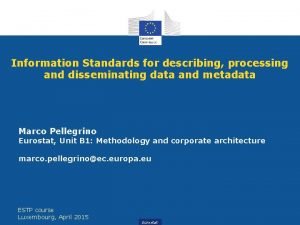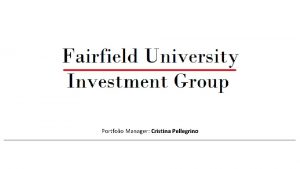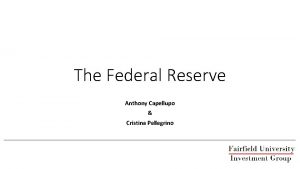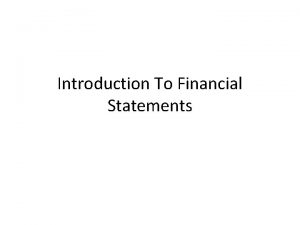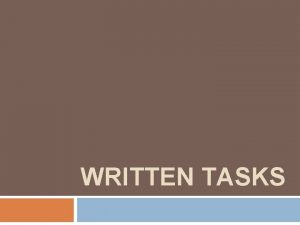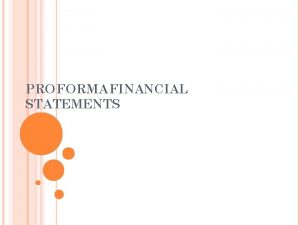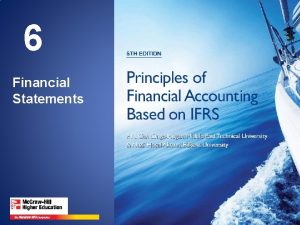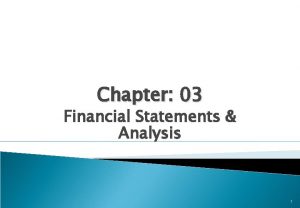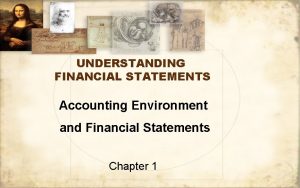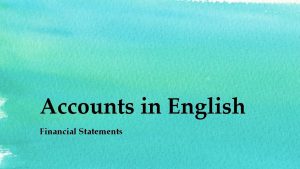Financial Statements Cristina Pellegrino Financial Statements The written

















- Slides: 17

Financial Statements Cristina Pellegrino

Financial Statements • The written records that provide users with information about the business activities of a company as well as the financial performance • Three Main Financial Statements: • The Balance Sheet • The Income Statement • The Statement of Cash Flows • Where can you find the financial statements? • www. sec. gov • Company Investor Relations Page • Fact. Set

The Balance Sheet • Provides an overview of a company’s assets, liabilities, and stockholders’ equity at a specific point in time. • Basic Balance Sheet Formula • Assets= Liabilities + Stockholder’s Equity • We use ratios to evaluate the balance sheet

The Balance Sheet: Assets

The Balance Sheet: Liabilities and SE

Balance Sheet Important Metrics • Current Ratio= Current Assets/ Current Liabilities • A company’s ability to pay short-term obligations • Debt to Equity= Debt/ Equity • Higher means more aggressive financing • Significant debt companies usually trade at a discount • Net Working Capital= Current Assets – Current Liabilities • This equation is sometimes adjusted • A company’s ability to meet current obligations and invest in other activities • Book Value= Total Assets- Intangible Assets- Liabilities • Total assets that shareholders would receive if the company was liquidated

The Income Statement • Provides insight into a company’s past performance over a specified period of time • Basic Income Statement Formula • Net Income= Revenues - Expenses

The Income Statement

The Income Statement: Gross Profit • Gross Profit= Revenue- Cost of Goods Sold • Revenue: Money generated from sale of product or service • COGS: Cost of materials directly related to sale or service • Gross Profit: Profit after deducting costs associated with making products or providing services

The Income Statement: Operating Income (EBIT) • Operating Income= Gross Profit- Op. EX • Op. Ex: Indirect costs of operating the business • Operating Income: Profit from a company’s core operations

The Income Statement: Net Income • Net Income= EBIT – Interest - Taxes • Interest: Tax deductible interest on company debt • Taxes: Tax Rate *( EBITInterest) • Net Income: “Earnings”

The Income Statement: Important Margins • Margins are profits as a % of revenue • Gross Margin: Gross Profit/ Revenue • Operating Margin: Operating Profit/ Revenue • Net Margin: Net Income/ Revenue

The Statement of Cash Flow • Shows users how well a company generates cash to fund operations, to fund investments, and to pay for debt for a specific period of time. • Three Main Activities: • Operating: Sources and uses of cash from running the businesses core operation • Ex. Net Income +D/A - Change in NWC • Investing: Sources and uses of cash for the future of the company, basically capital expenditures. • Ex. Money on PPE • Financing: Sources of cash from investors, banks, etc. Also cash paid to shareholders. • Ex. Dividends, stock buyback

The Cash Flow Statement

How They Relate t Ne e m o Balance Sheet E si R Inc C, Ch a es ng om c be rest t b te e D In Income Statement NW Net Income, Dividends, D&A e in Ca De bt sh Cash Flow Statement Investors are most interested in CASH

Free Cash Flow • Free Cash Flow: Cash left over after a company pays for its operations and capital expenditures. • Cash left over to pay lenders or give value to investors. Great value indicator. • Dividends, share buybacks, reinvestment, etc. Free Cash Flow= EBIT* (1 -tax rate) + D&A – CAPEX – Change in NWC • NOPAT= EBIT*(1 -tax rate)+ D&A • Excludes interest because interest payments are cash going to lenders • D&A: Noncash expenses that are included in opex as an accounting tool • CAPEX: Money on things such as PPE • Change in NWC: Current Assets (Not cash)- Current Liabilities (Not Debt) • Increase means change in operating liabilities has increased more than current assets. The use of cash has been delayed; therefore Free Cash Flow has increased.

What Resources To Use • Fact. Set • Dimenna Nyselius Library (https: //librarybestbets. fairfield. edu/finance) • Morningstar Investment Research Center • Value Line • Mergent Online • Seeking Alpha • FINVIZ • Tradingview • Investor Presentations • 10 K
 Marco pellegrino
Marco pellegrino Các châu lục và đại dương trên thế giới
Các châu lục và đại dương trên thế giới Dot
Dot điện thế nghỉ
điện thế nghỉ Bổ thể
Bổ thể Thế nào là sự mỏi cơ
Thế nào là sự mỏi cơ Phản ứng thế ankan
Phản ứng thế ankan Làm thế nào để 102-1=99
Làm thế nào để 102-1=99 Thiếu nhi thế giới liên hoan
Thiếu nhi thế giới liên hoan Vẽ hình chiếu vuông góc của vật thể sau
Vẽ hình chiếu vuông góc của vật thể sau Bài hát chúa yêu trần thế alleluia
Bài hát chúa yêu trần thế alleluia Một số thể thơ truyền thống
Một số thể thơ truyền thống Sơ đồ cơ thể người
Sơ đồ cơ thể người Cong thức tính động năng
Cong thức tính động năng Bảng số nguyên tố
Bảng số nguyên tố Tỉ lệ cơ thể trẻ em
Tỉ lệ cơ thể trẻ em đặc điểm cơ thể của người tối cổ
đặc điểm cơ thể của người tối cổ Các châu lục và đại dương trên thế giới
Các châu lục và đại dương trên thế giới
